|
| Frontier Pro Filter |

|
Water Purification
Aqua Mira Frontier Pro Filter (2.3 ounces) and
Chlorine Dioxide Tablets
The combination of a small "straw" filter and chlorine dioxide tablets has become my standard
water purification system, replacing my previous practice of carrying a water purifier pump.
Chlorine dioxide tablets are sold by AquaMira, and also by Katadyn (under the MicroPur trademark.)
Chlorine dioxide tablets impart little or no bad taste to the treated water. The tablets' weight is negligible.
They are simple to use. You just put in one tablet per liter of water, wait 3 hours, and the water is ready
to drink. The big disadvantage of chlorine dioxide is the 3 hour waiting time. These tablets are great for treating
water overnight, but not so good if you need water to drink right away.
To supplement the chlorine dioxide tablets, I use the AquaMira Frontier Pro filter. It
is very compact, and weighs only 2.3 ounces. It is a versatile filter and you can either filter the water as you drink through it like a straw, or you can filter the water into another container
by removing the bite valve (which comes off if you just twist and pull.)
The filter will screw on directly to a Platypus bladder, which
is the easiest way to filter water into another container. I fill a 3 liter Platypus bladder with "dirty" water, then
screw on the filter, remove the filter's bite valve, and squeeze the Platypus bladder a bit to increase pressure. Clean
water comes out of the filter, and I can fill up my "clean" drinking containers with this water. I've found that it
takes about three and a half minutes to filter one liter of water in this manner.
Obviously, the filter will also work in "straw" mode, allowing you to completely forego the need
for a "clean" water container, so long as you always drink directly from the filter.
I used the Frontier Pro on a two person, 9 day backpacking trip as a supplement to chlorine dioxide
tablets. It was perfect in this context. We would treat 3 liters of water every night with chlorine dioxide,
and use the Frontier Pro to provide extra water during the day, after we'd consumed the water we'd treated the night
before.
I don't see myself ever going back to a traditional purifier pump. The savings in
weight and bulk with a chlorine dioxide/Frontier Pro system is just too great, offsetting whatever added convenience a pump
may have.
Hydration and Energy
I use a hydration bladder both backpacking and climbing. It
is the most convenient way to drink while on the move. The Camelback 100 ounce bladder is my standard choice.
I like the wide opening, which makes addind ice or cleaning easy. For use In the winter, I have eliminated the bite
valve, which seems prone to freezing up. I have replaced it with a simple on/off valve that seems more resistant to
freezing (but you still need to be very careful to blow ALL the water back
into the bag) Although you are warned not to, I routinely use sports drinks in
my bladders. They aren’t that hard to clean up, and I need the electrolytes.
I am a convert to energy gels.
I eat them on just about every outdoor activity I pursue. However, I hate
dealing with the packaging. The empty packages are sticky and take up space,
and it’s a pain to try to open one with gloved hands. So, I prefer a soft
Gel Flask. I’ve tried a number of flexible plastic flasks, but the Venture
Design Works Soft Flask (marketed by Gel-Bot) is easily my favorite. It’s
soft, and flexible like a plastic bag, so you can suck every single ounce of gel out of it easily. It has a simple, effective bite valve, so you can just bite down and suck out some gel. Very easy to use without ever having to stop.
http://www.venturedesignworks.com/softflask.html
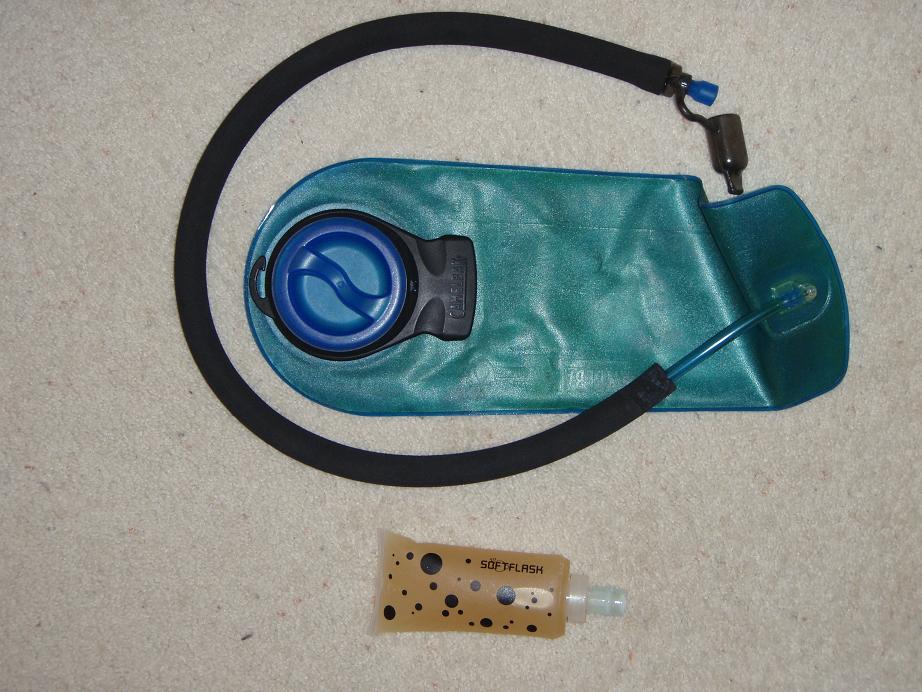
|
| Winterized Camelback 100 ounce bladder and Soft Flask |
Suunto Vector Altimeter watch
The Suunto Vector is a watch, a compass, an altimeter, barometer,
and thermometer. I have used Casio and Avocet altimeter watches, and I prefer the Suunto Vector. The altimeter is very accurate,
comparable to that of the Avocet and better than that of the Casio. The barometer function is very useful for tracking weather
trends, and the watch has a graph which shows barometric pressure trends. Both the altimeter and barometer automatically take
readings every hour, and these are saved in memory, so you can call up a 24 hour record of changes in altitude/barometric
pressure which is useful in gauging your climbing progress or using barometer trends to predict weather patterns. The Vector
has a good backlight, which can be used to illuminate the display no matter what function is currently being utilized. There
are a host of alarm functions, including time and altitude alarms. The compass works well, although it will not take the place
of a precision sighting compass for delicate orienteering work. The battery can be easily replaced by the user. All in all,
the Vector is a well designed, useful instrument.
I have two complaints about the Vector. One is that it is too big
to be worn comfortably on the wrist while climbing. The Vector is so large that it gets in the way of an ice axe leash when
ice climbing and similarly gets in the way when crack climbing on rock. I have solved this problems by simply wearing it on
a lanyard around my neck. Suunto sells a lanyard for this purpose, but be aware
that in cold weather, the rubber connector (which is designed to break away if it gets caught on something so you don’t
get choked) can come apart by itself.
The other issue with the Vector is its weak alarm. I rely on the Vector to wake me up for early morning alpine starts, but have found that I can’t hear
the alarm when I’m in my sleeping bag. The watch does have 3 alarm settings,
and I’ve found that if I set them all to go off 1 minute apart, by the 3rd time, I can almost always hear
it. Still, it’s something to keep in mind, and in weather that is not too
cold, (where I’m not worried about batteries being drained) I will put the Vector in a tent pocket or somewhere else
where the alarm will not be muffled by my sleeping bag.
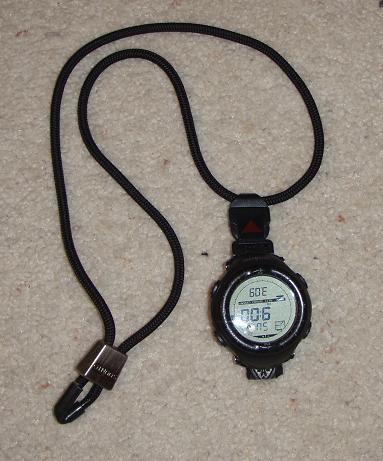
First aid kit
My idea of a first aid kit is that if I'm going to carry one, it
should have enough stuff in it to be useful if it is needed. I try to carry the minimum to treat large gashes/punctures, blisters,
and pain. I don't carry SAM splints and the like for immobilizing broken bones, as I can improvise splints out of cloth tape
and pieces of my pack frame, trekking poles and the like. (Yes, I have done this before, and it will work, with a little ingenuity.)
My basic first aid kit weighs 5.5 ounces, including the case, which
also holds other small stuff I don't want to lose at the bottom of my pack, such as my wrench and files for my ice tools,
cigarette lighter, and pocket knife.
My basic first aid kit consists of the following stuff, although
I will sometimes add or subtract items depending on the type and length of trip: (top
to bottom, left to right)
2 Aloksack waterproof bags (protects the contents and can be used
for mxing up a sterile solution for irrigating wounds)
Band Aid blister dressings (Sold in Europe as “Compeed” dressings,)
these are the best blister protection there is. They go directly over the blister, cushioning and protecting)
Dermabond surgical glue (basically, superglue formulated without
chemicals that irritate skin)
Proxi strips (for closing wounds, better adhesion than butterfly
strips)
Sterile military trauma dressing (unfolds to 6" x 6"; for big wounds
and major bleeding; can double as a sling)
2 band aids
2 Sterile Gauze Pads
Celox clotting agent (for stopping major bleeding) For a serious wound, application of direct pressure may be inadequate to stem the blood flow, particularly
if an artery has been compromised. Celox is a quick clotting agent that can help
to get blood flow staunched.
Morphine tablets oxicodone tablets, and vicodin tablets (for SERIOUS
pain)
Ibuprophin (relieves swelling associated with sprains and the like)
Buffered aspirin (best all around analgesic, helps to combat altitude
sickness, and improves circulation.)
Small roll of 1" medical tape (hundreds of uses)
Small bottle of betadine (for cleansing wounds)
Triple
antibiotic ointment
Antiseptic
towlettes
Burn
gel
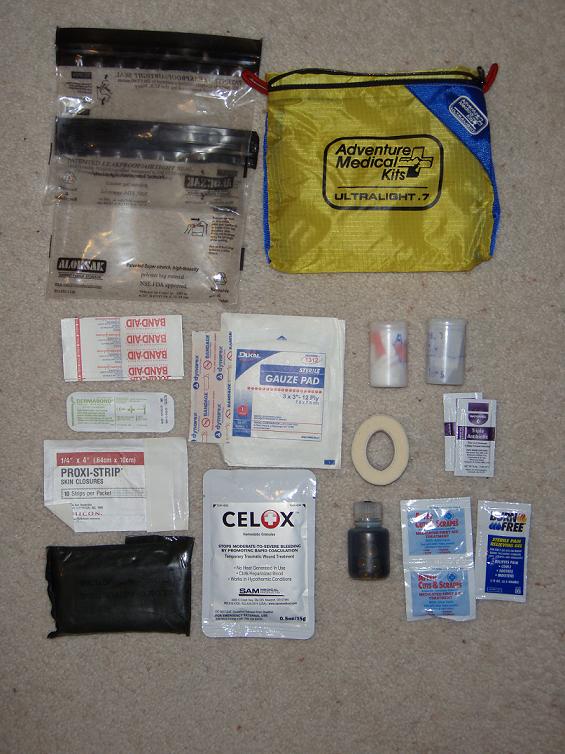
Other Emergency Items
A
small bit of duct tape, and some ripstop repair tape are two things which I typically put in my first aid kit for repairing
tents and other things that need fixing.
I always take a lighter with me. It weighs almost nothing, and it’s
always a good idea to be able to start a fire.
For trips where I will be spending time below treeline, (dayhikes and backcountry skiing day trips for example),
I will usually take with me a small fire starting kit. I’m partial to the
Sparklite kit. It weighs less than an ounce, and combines an idiot-proof sparking
flint and steel with some waterproof tinder made from cotton cord impregnated with petroleum.
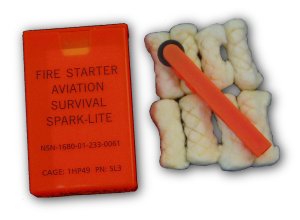
Insect Repellent
I have tried a number of alternatives to traditional DEET based
insect repellent, including citronella, skin so soft, neem, lemon grass, and several other herbal based concoctions. Although
these non-DEET formulas work reasonably well for the back yard barbecue, none of them have worked for me in the backcountry
for repelling clouds of hungry mosquitos. I have resigned myself to using DEET, but have tried to find the least toxic form
of it that I can. After a fair amount of research on the Web and in print, I now use Ultrathon by 3M. Ultrathon uses an encapsulated
form of DEET that reduces the amount of DEET that is absorbed through the skin into the blood. After using Ultrathon for quite
a while, my experience has been that it is as effective as other DEET formulations I've used for repelling insects. Its enhanced
safety therefore makes Ultrathon my bug repellent of choice.
Backpacking
hygiene
I used to carry toilet
paper when backpacking. For long trips, with infrequent opportunities to wash,
I now much prefer carrying a travel pack of diaper wipes. A single wipe is usually
all that is needed, and you can get yourself a lot cleaner with a wipe than with a handful of t.p.
One warning: Don’t carry wipes in below-freezing weather, they will freeze into a solid,
unusable block.
Backpacking
tableware
I love Orikaso bowls. When unfolded, they are easy to store because they are flat and take up almost no pack volume. They are cheap, light, and you can wash them when flat, so they are very easy to clean. Most of the
time, I just flatten them out and lick them clean.
http://www.orikaso.com/
The mug is a bit fiddly for my tastes
(and I prefer a lightweight titanium mug that I can heat over a stove or fire) but the Orikaso bowl is now my sole backpacking
bowl. (For cold weather trips when I'm using a butane stove, however, I take a Snowpeak
titanium bowl, as it is large enough to warm up the butane canister using warm water.)
| Orikaso Bowls at a bivi site |
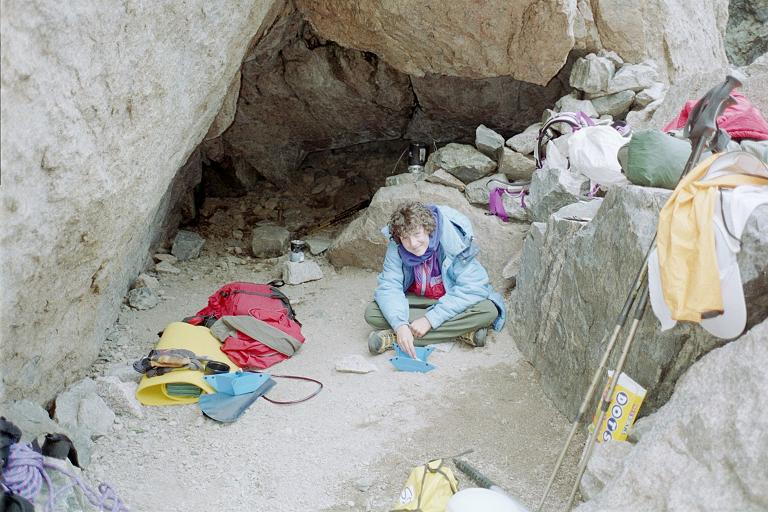
|
GSI Outdoors makes my favorite camping spoon. It's called the
"Lexan Rehydrate Spoon." It's main design feature is a long handle, which makes it much easier to eat directly from
the pouch of a freeze dried dinner. Besides that, it's light, tough, and cheap. REI makes a similar long-handled
spoon out of titanium.
| GSI "Rehydrate" Spoon |
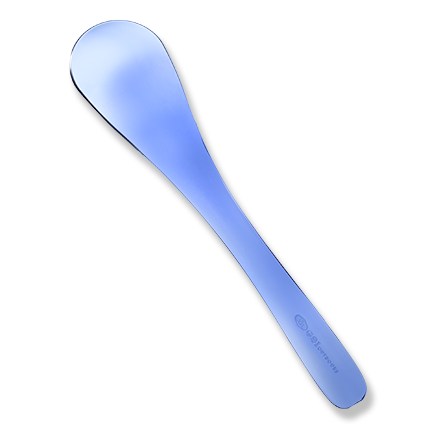
|
Komperdell C3 Airshock Carbon Fiber Trekking Poles
(7.2 ounces each)
These are some very lightweight, 3 piece trekking poles, constructed with
carbon fiber. However, they have a (well deserved) reputation for the locking mechanism to fail and the sections collapse.
I used these poles on a number of trips. Initially, I loved them. Their light weight was terrific, and the handles
and straps make them very comfortable to use. For a while, I didn't experience any loosening of the locking mechanism
or collapsing of the poles.
However, after about 15 days of use, the poles began to loosen and collapse more and more often,
until the poles became almost unusable. Rather than simply return them, I took them apart to see what the problem was.
Here is what I found:
| Broken Locking Mechanism |
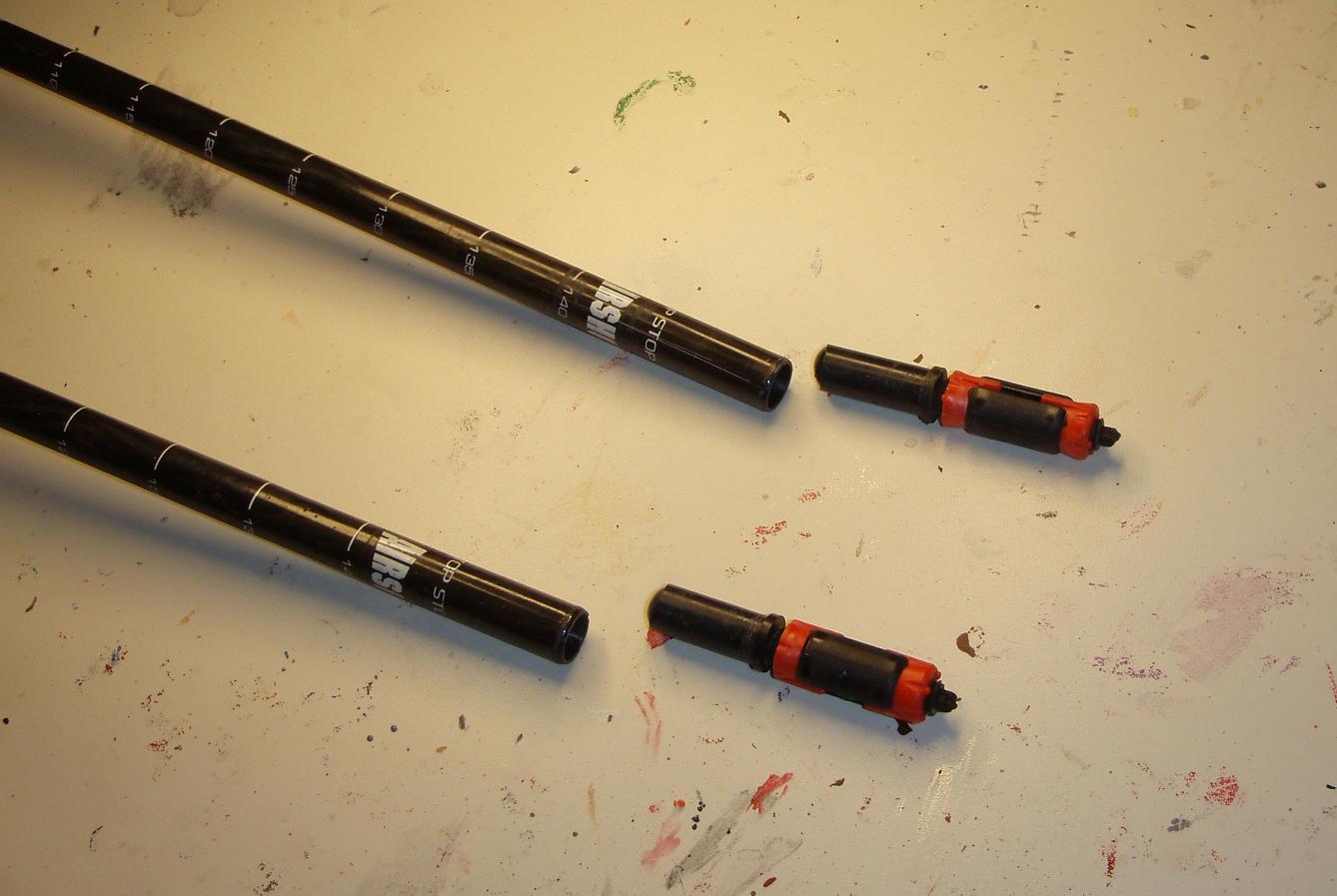
|
| Komperdell C3 Airshock Poles |
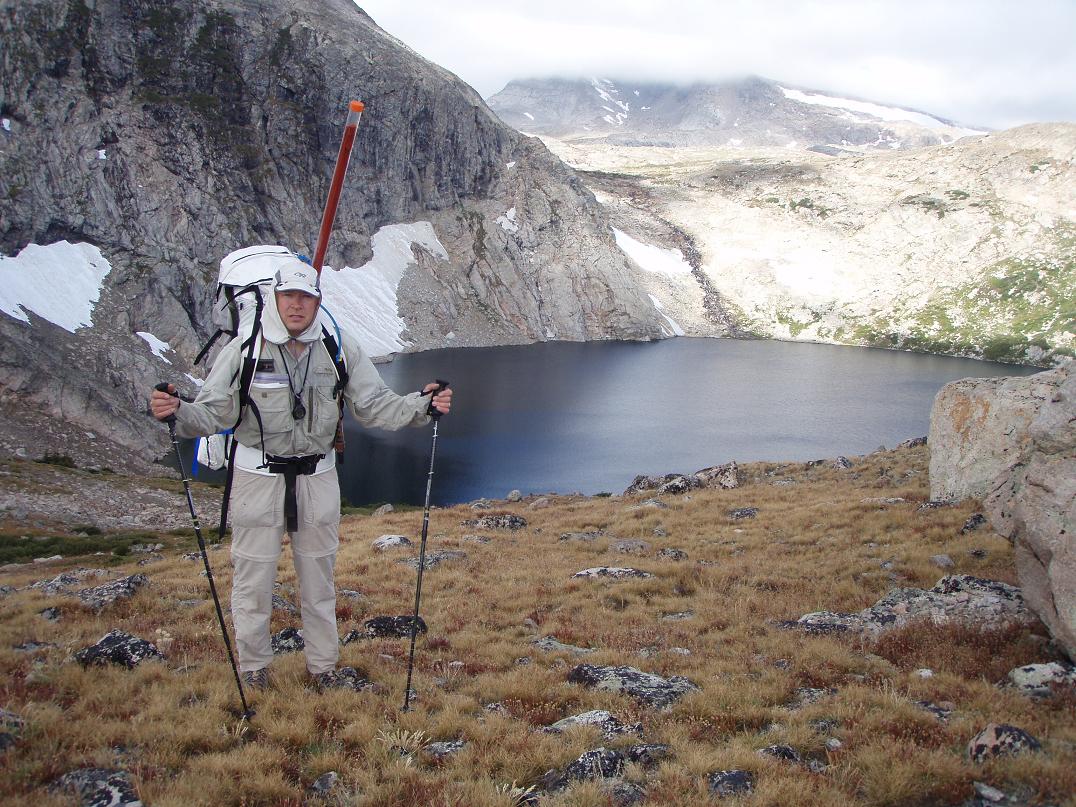
|
The locking components were not securely set into the pole sections,
so when twisting the poles to tighten them up, the locking component had the tendency to simply stay in place, with the pole
section turning. This prevented the locking mechanism from tightening sufficiently to lock the pole sections in place.
This problem became worse in cold weather, perhaps because of the different contraction properties of the carbon fiber
shaft and the plastic plug.
I fixed this by using some epoxy glue to glue the locking component
securely into the pole section. The epoxy didn't work all that well, and I then turned to Gorilla glue. The Gorilla
glue worked fine, but then the plastic on the locking mechanism snapped. I haven't been able to locate any replacement
lock cores that will fit the carbon poles. Komperdell also doesn't seem to have any customer service reps in the United
States.
It's a real hassle, because these poles weren't cheap, and as much as I appreciate their
light weight, they really have had problems almost from the beginning. I should have Googled these poles before I bought
them, as there are a number of reviews on the internet that complain about the locking mechanism failures. It's clearly
a bad design.
I recently replaced these with some 3 piece Black Diamond carbon fiber poles, the Black Diamond
CF alpine poles. So far, I've been impressed with the BD poles' very secure flicklock mechanism. Also, I have
some (excellent) experiences with Black Diamond customer service, so I'm not worried about getting "shafted" if the new BD
poles are defective.
|

